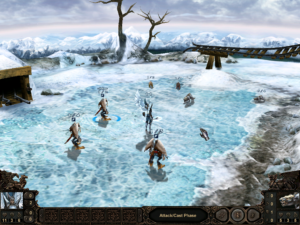Etherlords
 I recently mentioned that the magic system in Puzzle Quest was reminiscent of Magic: the Gathering, but here’s a game that takes that to an extreme. Etherlords is basically a turn-based strategy game with mechanics on the large scale derived from Warlords and Heroes of Might and Magic, but combat mode is very specifically patterned after the mechanics of M:tG. Both sides have a hand of spells chosen at random from your “library” (or deck); spells in hand are used up when cast, but you automatically draw one new one every turn. Some of those spells summon creatures, which are characterized chiefly by two numbers, attack rating and health. The summoned creatures can be sent to attack the opponent, but can be blocked by your opponent’s creatures, and so forth. Concepts like “summoning sickness” are imported without alteration.
I recently mentioned that the magic system in Puzzle Quest was reminiscent of Magic: the Gathering, but here’s a game that takes that to an extreme. Etherlords is basically a turn-based strategy game with mechanics on the large scale derived from Warlords and Heroes of Might and Magic, but combat mode is very specifically patterned after the mechanics of M:tG. Both sides have a hand of spells chosen at random from your “library” (or deck); spells in hand are used up when cast, but you automatically draw one new one every turn. Some of those spells summon creatures, which are characterized chiefly by two numbers, attack rating and health. The summoned creatures can be sent to attack the opponent, but can be blocked by your opponent’s creatures, and so forth. Concepts like “summoning sickness” are imported without alteration.
In fact, the combat mechanics are so close to M:tG that it’s more instructive to list the ways in which they differ. Things are tuned so matches generally end faster than in M:tG, as is reasonable for the context. Attackers hit before blockers, rather than both damaging eath other simultaneously. And, in general, Etherlords takes advantage of the fact that it’s not a direct adaptation of a card game by discarding some of the more literal points of simulation. Spells are not drawn without replacement, like cards from a deck: you have exactly fifteen spell slots, and when you draw, each has a 1 in 15 chance of coming up, even if you already have another copy of it in your hand. (If you want a spell to come up more frequently, you can assign it to multiple slots.) Also, there are no “land cards”: the mana you need to cast spells comes from “mana channels”, which automatically increase in number over the course of combat, at a rate determined by the hero’s experience level. Thus, more powerful characters are able to cast more powerful spells earlier.
There are no “colors” of mana, but the four armies in the story, and the sorts of spells they get, clearly correspond to the red, green, blue, and black magic in M:tG — but with the interesting alteration that black creatures, instead of undead, are primarily cyborgs. (White magic is left out: as the intro cutscene makes clear, there are no good guys in this story. Everyone involved is motivated solely by lust for power.) As a result, it feels a little strange that the spells are all so different. For example, if you have a primarily green deck in M:tG, you’re likely to spend your first turn summoning Llanowar Elves (1/1, tap for 1 green mana). 1At least, that’s how it went when I last spent time playing M:tG, many years ago. It might all be different now. Llanowar Elves are almost essential to what it means to have a green deck, and Etherlords doesn’t even provide a close analog to them. Instead, your basic low-level green summon is Spitting Fingus (0/2, can’t attack, sacrifice to do 1 damage to target hero or creature) — something that M:tG would probably make blue or black. It’s like a version of M:tG from an alternate universe where some early design decisions went differently.
As in Warlords and HOMM, there are basically two sorts of things you fight: enemy heroes, and “wild” creatures not allied with any side (and typically set on crucial choke points on the map or guarding valuable resources). But even the wild encounters have heroes, because that’s essential to how M:tG-style combat works. If you encounter a giant rat on the road, the combat will be against a rat spellcaster that summons other sorts of rats, smaller versions of itself. There generally seem to be three or four versions of every summonable creature type to support this kind of specialization.
The first time I tried playing Etherlords, back in 2001 or 2002, I found myself unable to make headway on the third map of the campaign, and eventually gave up. (Frustration with long loading times was also a factor. I think my system at the time didn’t really have enough memory for all the graphics, and had to swap even as it loaded. Anyway, moot now.) I think my main problem, as is usually the case for me in games of this sort, was timidity: I didn’t want to commit to invading enemy territory until I knew my heroes were tough enough, when I should have been out there stealing resources before the enemy could get to them. I’m thinking now that the key is to be clever enough in your choice of spells that your hero can take on enemy heroes that are nominally more powerful. We’ll see how that pans out.
| ↑1 | At least, that’s how it went when I last spent time playing M:tG, many years ago. It might all be different now. |
|---|
 Comments(0)
Comments(0)